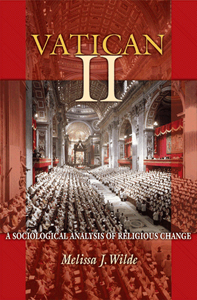Many Catholics believe that continuity and change come to their church through divine inspiration or papal pronouncements. Some believe the two are one and the same. Melissa Wilde, an assistant professor of sociology, looks at religious change by studying the interplay of social movements and culture within sacred institutions. Her social-scientist’s take on the Second Vatican Council (1962-65), “the most significant example of institutionalized change since the Reformation,” is laid out in her book Vatican II: A Sociological Analysis of Religious Change. Wilde’s groundbreaking work recently won the 2008 Distinguished Book Award from the Society for the Scientific Study of Religion.
By most accounts, the vistas opened up and new directions taken by the Council fathers were unexpected—even revolutionary—for a rigid institution that prizes tradition and centralized authority “By the time it was finished, on December 8, 1965,” Wilde writes, “the Council had turned the Church on its head…Most importantly, Vatican II changed the way the Church understood itself, as its identity went from being a hierarchical authority to a church conceived as the people of God.”
Wilde’s breakdown of how that happened is a big-picture analysis of big institutional religious change. Her research draws on more than 80 transcripts of interviews with key bishops, cardinals and theological experts who took part in the Council. She also mined several archives of personal correspondence and committee meeting minutes as well as materials from the Vatican Secret Archive, which recorded the votes of the Council’s 2,500 prelates.
The first surprise is that Vatican II was convened at all. John XXIII was a 77 year-old place-holder pope who had been elected to sit on the papal throne by cardinals who couldn’t agree on a more suitable candidate. Just three months after his elevation, the new pope called the world’s bishops to Rome. The papal Curia, the conservative men in charge of Church administration and doctrinal purity, had a powerful hand on the preparations, proceedings and agenda for Vatican II. There was little hope of substantive reform. “Though the pope provided the opportunity for change,” Wilde writes, “with rare exceptions the bishops decided the direction and extent of that change. Ultimately, they decided to change a great deal.”
The bishops who converged on the Vatican were divided between prelates who strove to maintain the long-established image of the church and those who sought to bring about reforms that would make it more responsive to needs of the modern world. A “shift in expectations” occurred at the Council’s outset, when a group of progressive bishops organized to reject the Curia’s program. They were successful, demonstrating that change was not just needed but possible. Wilde reports that this and other first-session revelations showed the assembly that many among them were ready to do more than follow the Curia’s lead. “The pronouncements of the Council were not merely reflections of papal will as most assume,” says Wilde, “but the product of a dramatic confrontation between progressives and conservatives, which began during the first days of the Council.”
Wilde parses the bishops into four factions, each with priorities determined by the political circumstances and cultural character of its geographical region. The “overwhelmingly progressive outcome,” Wilde found, was due in large measure to progressive bishops’ eagerness to discuss, lobby, collaborate, persuade and compromise. “Progressives believed in the doctrine of ‘collegiality,’ which stated that the bishops convening together have the same teaching authority as the pope.” They didn’t ask permission to be collegial but acted as though the principle were true. Conservative bishops found the idea of episcopal collegiality threatening to papal authority and restricted much of their efforts to “a letter-writing campaign to the pope,” a tactic that turned out to be a disadvantage in the “collective effervescence” of the Council.
“Given the situation at the start of the Council,” Wilde writes, “many saw the unexpected and sweeping changes that came from it as nothing short of miraculous. In Vatican II, she lays bare the organizational wheels that turned out that miracle.



